
WELCOME!
to
St. Agatha’s Tower
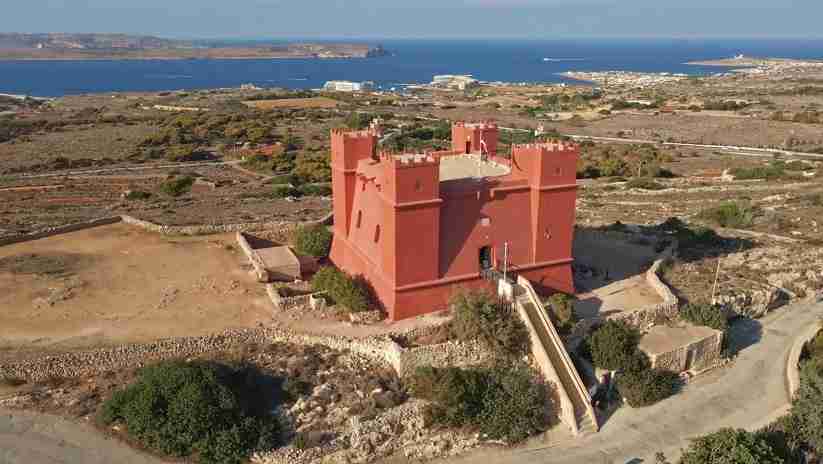
St Agatha’s Tower, also known as the Red Tower, was built in 1649 and was manned during both World Wars. It provides excellent all round views of Gozo, Comino and the Għadira Nature Reserve.
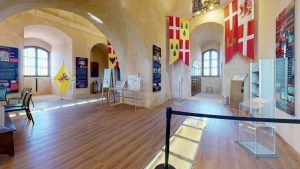 This Tower is situated on the crest of Marfa Ridge. A shallow alcove within the Tower, housed a chapel dedicated to St Agatha. It is also known as the Red Tower due to the colour it was painted, and this colour was retained on restoration. It was completed in 16 49 during the rule of Grand Master Jean Paul Lascaris Castellar.
This Tower is situated on the crest of Marfa Ridge. A shallow alcove within the Tower, housed a chapel dedicated to St Agatha. It is also known as the Red Tower due to the colour it was painted, and this colour was retained on restoration. It was completed in 16 49 during the rule of Grand Master Jean Paul Lascaris Castellar.
This Tower was one of the main defensive positions during the time of the Knights of St John and was equipped with cannon and a garrison of 30 men, and supplied with enough food and ammunition to withstand a siege of 40 days. The entrance to the Tower is approached by a flight of steps originally separated from the door by a drawbridge. It is square in plan with four corner towers rising from the base.
The outer walls are about four metres thick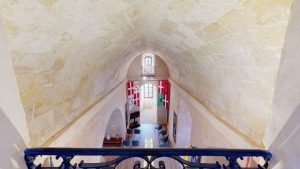 through which small windows were cut. A low star-shaped entrenchment serving as a gun platform built in the rear flanks of the Tower is an eighteenth century addition. During the British period it was used for defence purposes and was manned during both World wars.
through which small windows were cut. A low star-shaped entrenchment serving as a gun platform built in the rear flanks of the Tower is an eighteenth century addition. During the British period it was used for defence purposes and was manned during both World wars.
In recent times it was equipped as a radar station by the Armed Forces of Malta. The first phase of the restoration of the Tower commenced in 1999 and was completed in 2001. One turret was missing and another turret severely damaged and its walls and roof were rebuilt and eroded stone replaced.
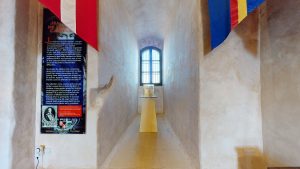 The interior walls were scraped and painted and the original floor was uncovered. Due to the extreme unevenness of the floor, this was covered by a wooden surface with glass apertures through which it is possible to view the original slabs. An interior wooden spiral staircase was also constructed replacing a stone staircase which led to the flat roof and which had been removed. The roof commands magnificent views of Malta, Gozo and Comino.
The interior walls were scraped and painted and the original floor was uncovered. Due to the extreme unevenness of the floor, this was covered by a wooden surface with glass apertures through which it is possible to view the original slabs. An interior wooden spiral staircase was also constructed replacing a stone staircase which led to the flat roof and which had been removed. The roof commands magnificent views of Malta, Gozo and Comino.
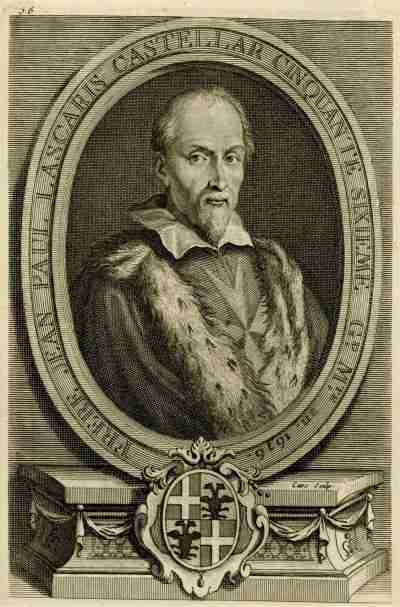 Jean Paul Lascaris Castellar, Bailiff of Manosque, of the noble Genoese family of Vintimiglia, and a descendant of Theodore Lascaris, Emperor of Constantinople, was seventy six years of age at the time of his election on the 13th June 1636. He had joined the ranks of the fraternity in Malta under Cardinal Verdalle’s rule, and was attached to the language of Provence.
Jean Paul Lascaris Castellar, Bailiff of Manosque, of the noble Genoese family of Vintimiglia, and a descendant of Theodore Lascaris, Emperor of Constantinople, was seventy six years of age at the time of his election on the 13th June 1636. He had joined the ranks of the fraternity in Malta under Cardinal Verdalle’s rule, and was attached to the language of Provence.
The first aim of Lascaris on assuming the reins of Government was to endeavour to pacify the offended Prince of Paterno, Viceroy of Sicily, who, during the fierce war which was raging at the time between France and Spain, had forbidden the exportation of grain to Malta. This step was taken by the Viceroy in revenge for the sympathies and support which the preponderating French element among the Knights of St. John had shown towards France during the conflict. As Malta had always looked to the neighbouring island of Sicily for its supply of grain the Viceroy’s edicts would have practically meant starvation, and it was mainly due to the tact and exertions of Lascaris that the prohibition was finally withdrawn.
Under the energetic rule of this Grand Master the navy of the Order was still further strengthened, and naval expeditions against the Turks were carried out on an even larger scale than formerly. In 1644 six galleys of the Order, under Boisboudrant, captured a large and powerful Turkish galleon whilst, cruising off Rhodes, after a fierce and sanguinary struggle with eight of the enemy’s vessels. Over 600 Turks were killed in engagement, and the Order had to deplore the loss of 120 men including their gallant captain, Boisboudrant.
Among the captives was the young Basseba, Sultana of the Imperial harem of Ibrahim, with her infant son Osmal, on a pilgrimage to Mecca. The Sultana died shortly after her arrival in Malta, and the child was educated and received into the Catholic Church. He subsequently joined the Dominican Order of Preachers, under the name of Father Ottoman. and died in Malta in 1676 while Prior of Porto Salvo.
The Sultan, irritated at the loss inflicted by the Knights of Malta in the engagement off Rhodes, threatened to carry war into the enemy’s country, and dispatched heralds to the Grand Master informing him of his intentions. Lascaris upon this at once took steps to resist an invasion. Knights were summoned to Malta from their commanderies abroad, and many volunteers from all over Europe hastened to the island in the hope of participating in a second siege of Malta, possibly still more glorious than that which had brought such lasting fame to la Vallette and his gallant hand of heroes in 1565. Viscount D’Arpajou brought at his own expense a reinforcement of 2,000 men, which he placed at the disposal of the Order. The gratitude of the Grand Master and of the fraternity at this generous and unexpected offer was so great that D’Arpajou was amidst acclamation elected Commander in Chief of all the forces in Malta, a post hitherto always held by the Grand Marshal of the Order. Warned of the measures which were being taken in Malta to resist the might of the Turkish Empire, Ibrahim turned his gigantic force against the Venetian island of Candia, and thither the Maltese galleys, under the command of the Prior of La Roccella, at once repaired to assist the Venetians in their hour of peril.
The prosecution of the war in Candia, in which the Knights of Malta played so brilliant a part, did not prevent the Grand Master from making further improvements in the Convent and in the defences of the island. He engaged the celebrated Italian engineer Floriani to inspect the fortifications, and to add whatever in his opinion would be necessary to strengthen them. The several plans which this engineer submitted to the Grand Master and Council for the additional protection of the island were put into execution under Lascaris, and completed in 1721.
By a most judicious decree of this Grand Master, it was ordered, in 1650, that all books belonging to the members of the fraternity, both in Malta and in the various commanderies abroad, were not to be sold on the death of their owners, but were to be added to the library of the Order, which it was intended to open to the public. Such was the origin of the present magnificent public library of Malta, which since that date has been rapidly increasing, and now ranks high amongst the public libraries of Europe. The gratitude of posterity will recall the name of Lascaris as the founder of one of the most useful and enduring monuments which the island possesses.
On the 14th August 1657 Lascaris died at the venerable age of ninety seven years.